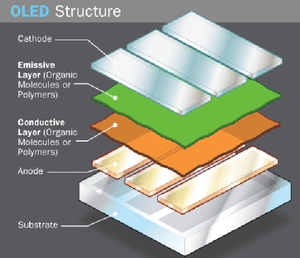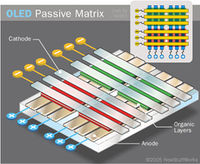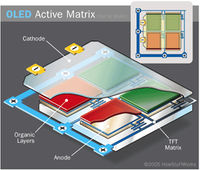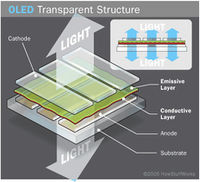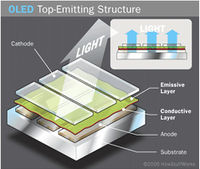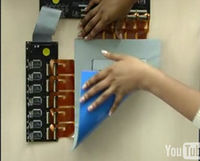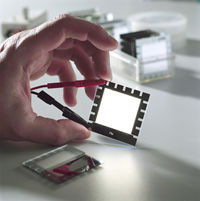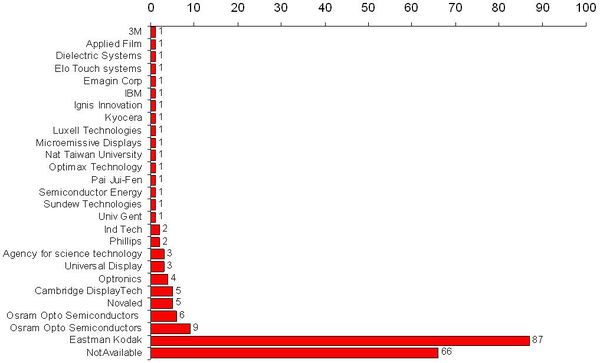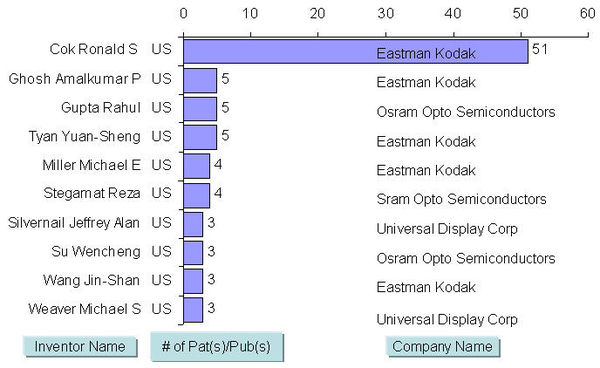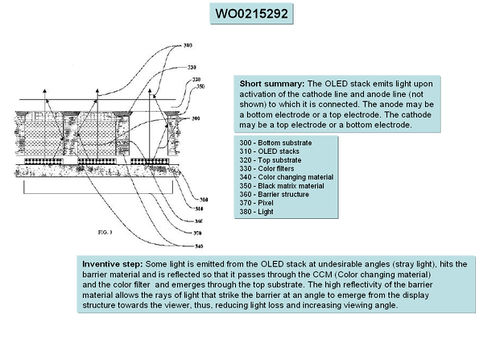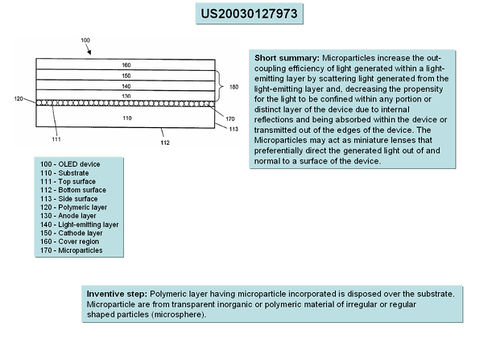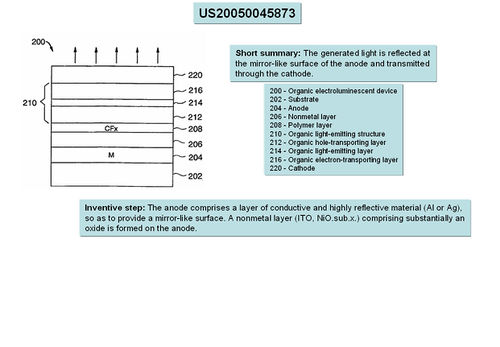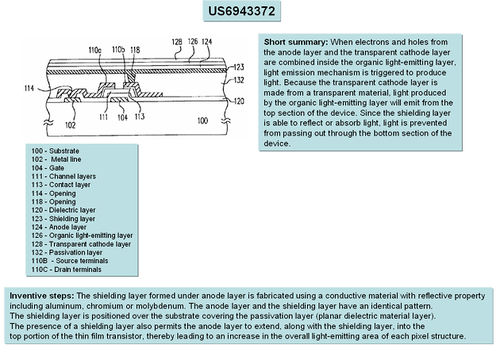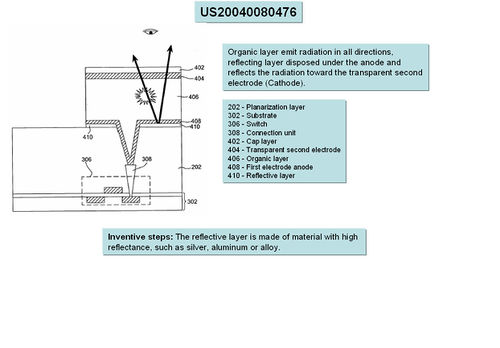Difference between revisions of "OLED - Organic Light Emitting Diode"
(→Working of OLED'S) |
|||
| Line 13: | Line 13: | ||
* Cathode (may or may not be transparent depending on the type of OLED) - The cathode injects electrons when a current flows through the device. | * Cathode (may or may not be transparent depending on the type of OLED) - The cathode injects electrons when a current flows through the device. | ||
==Working of OLED'S== | ==Working of OLED'S== | ||
| − | OLEDs emit light in a similar manner to LEDs, through a process called electrophosphorescence. | + | *OLEDs emit light in a similar manner to LEDs, through a process called electrophosphorescence. |
| − | The basic OLED cell structure consists of a stack of thin organic layers sandwiched between a transparent anode and a metallic cathode. The organic layers comprise a hole-injection layer, a hole-transport layer, an emissive layer, and an electron-transport layer. When an appropriate voltage (typically between 2 and 10 volts) is applied to the cell, the injected positive and negative charges recombine in the emissive layer to produce light (electro luminescence). The structure of the organic layers and the choice of anode and cathode are designed to maximize the recombination process in the emissive layer, thus maximizing the light output from the OLED device. | + | *The basic OLED cell structure consists of a stack of thin organic layers sandwiched between a transparent anode and a metallic cathode. The organic layers comprise a hole-injection layer, a hole-transport layer, an emissive layer, and an electron-transport layer. When an appropriate voltage (typically between 2 and 10 volts) is applied to the cell, the injected positive and negative charges recombine in the emissive layer to produce light (electro luminescence). The structure of the organic layers and the choice of anode and cathode are designed to maximize the recombination process in the emissive layer, thus maximizing the light output from the OLED device. |
| − | + | ||
==OLED Types== | ==OLED Types== | ||
There are several types of OLEDs | There are several types of OLEDs | ||
Revision as of 02:27, 16 February 2011
Contents
Introduction
The growing number of electronic devices using organic light emitting diode displays shows that after years of promise, the technology is increasingly finding place in many products. But while OLED displays might challenge LCDs as the screens of choice for smaller gadgets, the technology may not become mainstream for notebook PCs or TVs within this decade.
OLED displays use organic compounds that emit light when exposed to an electric current. They are brighter, have better contrast, offer wider viewing angles, use less power, and provide faster response times than liquid crystal displays. OLED screens' thickness is a third of that of LCDs, since they don't need a back-light, and that makes them a good fit for portable electronics devices.
OLED Components
An OLED consists of the following parts:
- Substrate (clear plastic, glass, foil) - The substrate supports the OLED.
- Anode (transparent) - The anode removes electrons (adds electron "holes") when a current flows through the device.
- Organic layers - These layers are made of organic molecules or polymers.
- Conducting layer - This layer is made of organic plastic molecules that transport "holes" from the anode. One conducting polymer used in OLEDs is polyaniline.
- Emissive layer - This layer is made of organic plastic molecules (different ones from the conducting layer) that transport electrons from the cathode; this is where light is made. One polymer used in the emissive layer is polyfluorene.
- Cathode (may or may not be transparent depending on the type of OLED) - The cathode injects electrons when a current flows through the device.
Working of OLED'S
- OLEDs emit light in a similar manner to LEDs, through a process called electrophosphorescence.
- The basic OLED cell structure consists of a stack of thin organic layers sandwiched between a transparent anode and a metallic cathode. The organic layers comprise a hole-injection layer, a hole-transport layer, an emissive layer, and an electron-transport layer. When an appropriate voltage (typically between 2 and 10 volts) is applied to the cell, the injected positive and negative charges recombine in the emissive layer to produce light (electro luminescence). The structure of the organic layers and the choice of anode and cathode are designed to maximize the recombination process in the emissive layer, thus maximizing the light output from the OLED device.
OLED Types
There are several types of OLEDs
- Passive-matrix OLED
- Active-matrix OLED
- Transparent OLED
- Top-emitting OLED
- Bottom-emitting OLED
- Foldable OLED
- White OLED
Passive-matrix OLED - PMOLED
PMOLEDs have strips of cathode, organic layers and strips of anode. The anode strips are arranged perpendicular to the cathode strips. The intersections of the cathode and anode make up the pixels where light is emitted. External circuitry applies current to selected strips of anode and cathode, determining which pixels get turned on and which pixels remain off. Again, the brightness of each pixel is proportional to the amount of applied current.
PMOLEDs are easy to make, but they consume more power than other types of OLED, mainly due to the power needed for the external circuitry. PMOLEDs are most efficient for text and icons and are best suited for small screens (2- to 3-inch diagonal) such as those you find in cell phones, PDAs and MP3 players. Even with the external circuitry, passive-matrix OLEDs consume less battery power than the LCDs that are currently used in these devices.
Active-matrix OLED - AMOLED
AMOLEDs have full layers of cathode, organic molecules and anode, but the anode layer overlays a thin film transistor (TFT) array that forms a matrix. The TFT array itself is the circuitry that determines which pixels get turned on to form an image.
AMOLEDs consume less power than PMOLEDs because the TFT array requires less power than external circuitry, so they are efficient for large displays. AMOLEDs also have faster refresh rates suitable for video. The best uses for AMOLEDs are computer monitors, large screen TVs and electronic signs or billboards.
Transparent OLED
Transparent OLEDs have only transparent components (substrate, cathode and anode) and, when turned off, are up to 85 percent as transparent as their substrate. When a transparent OLED display is turned on, it allows light to pass in both directions. A transparent OLED display can be either active- or passive-matrix. This technology can be used for heads-up displays.
Top-emitting OLED
Top-emitting OLEDs have a substrate that is either opaque or reflective. They are best suited to active-matrix design. Manufacturers may use top-emitting OLED displays in smart cards.
Foldable OLED
Foldable OLEDs have substrates made of very flexible metallic foils or plastics. Foldable OLEDs are very lightweight and durable. Their use in devices such as cell phones and PDAs can reduce breakage, a major cause for return or repair. Potentially, foldable OLED displays can be sewn into fabrics for "smart" clothing, such as outdoor survival clothing with an integrated computer chip, cell phone, GPS receiver and OLED display sewn into it.
White OLED
A white organic LED (OLED) incorporating a blue phosphorescent dye and a down-conversion phosphor has achieved a luminous efficacy of 25 lm/W. This high-efficacy device was enabled by lowering the device operating voltage, increasing the outcoupling efficiency, and incorporating highly efficient phosphorescent emitters.
Landscape Analysis Of Top-Emmission OLED
IP Landscape
- We have chosen the top emission OLED's as the area of focus.
- The top emission OLED's have been facing challenges to achieve optimimum efficiencies in terms of light reflection. Also, it's been a challenge to increase the life time of the top emission OLED's. Lots of initiative is seen in this direction, and below is a snapshot of research work done by organizations worldwide to achieve higher efficiency levels through better design.
Like this report?
This is only a sample report with brief analysis
Dolcera can provide a comprehensive report customized to your needs
Competitor Landscape
Competitor Mapping
| # | Assignee Name | 2001 | 2002 | 2003 | 2004 | 2005 | 2006 | 2007 | Total |
| 1 | Eastman Kodak | 1 | 3 | 23 | 24 | 24 | 12 | 87 | |
| 2 | Not Available | 3 | 10 | 9 | 20 | 18 | 6 | 66 | |
| 3 | Osram Opto Semiconductors | 2 | 1 | 4 | 2 | 9 | |||
| 4 | Osram Opto Semiconductors | 1 | 2 | 3 | 6 | ||||
| 5 | Cambridge DisplayTech | 1 | 4 | 5 | |||||
| 6 | Novaled | 1 | 2 | 2 | 5 | ||||
| 7 | Optronics | 4 | 4 | ||||||
| 8 | Agency for science technology | 2 | 1 | 3 | |||||
| 9 | Universal Display | 1 | 2 | 3 | |||||
| 10 | Ind Tech | 2 | 2 | ||||||
| 11 | Phillips | 1 | 1 | 2 | |||||
| 12 | 3M | 1 | 1 | ||||||
| 13 | Applied Film | 1 | 1 | ||||||
| 14 | Dielectric Systems | 1 | 1 | ||||||
| 15 | Elo Touch systems | 1 | 1 | ||||||
| 16 | Emagin Corp | 1 | 1 | ||||||
| 17 | IBM | 1 | 1 | ||||||
| 18 | Ignis Innovation | 1 | 1 | ||||||
| 19 | Kyocera | 1 | 1 | ||||||
| 20 | Luxell Technologies | 1 | 1 | ||||||
| 21 | Microemissive Displays | 1 | 1 | ||||||
| 22 | Nat Taiwan University | 1 | 1 | ||||||
| 23 | Optimax Technology | 1 | 1 | ||||||
| 24 | Pai Jui-Fen | 1 | 1 | ||||||
| 25 | Semiconductor Energy | 1 | 1 | ||||||
| 26 | Sundew Technologies | 1 | 1 | ||||||
| 27 | Univ Gent | 1 | 1 | ||||||
| 28 | Total | 1 | 5 | 14 | 36 | 58 | 66 | 28 | 208 |
Key Inventors
Key Inventor Mapping
| S.No | Top 10 Assignees of Last 5 Years | 2001 | 2002 | 2003 | 2004 | 2005 | 2006 | 2007 | Total |
| 1 | Cok Ronald S US | 2 | 12 | 13 | 13 | 11 | 51 | ||
| 2 | Ghosh Amalkumar P US | 1 | 2 | 2 | 5 | ||||
| 3 | Gupta Rahul US | 5 | 5 | ||||||
| 4 | Tyan Yuan-Sheng US | 1 | 3 | 1 | 5 | ||||
| 5 | Miller Michael E US | 1 | 1 | 2 | 4 | ||||
| 6 | Stegamat Reza US | 2 | 1 | 1 | 4 | ||||
| 7 | Silvernail Jeffrey Alan US | 2 | 1 | 3 | |||||
| 8 | Su Wencheng US | 1 | 2 | 3 | |||||
| 9 | Wang Jin-Shan US | 3 | 3 | ||||||
| 10 | Weaver Michael S US | 1 | 2 | 3 | |||||
| Total | 5 | 19 | 26 | 23 | 13 | 86 |
Technology Mapping
- In OLED devices not all internally generated light is coupled out of the device (only 20%-50%), which reduces the device efficiency and lifetime.
- Modification in structures are applied to improve outcouple efficiency in order to enhance the efficiency and lifetime of top emission OLEDs.
- Below is a snapshot of how various organizations are using different design structures, using the same principle of internal reflection, to achieve higher out-coupling efficiencies.
Comparison of out coupling of waveguiding light in top-emission polyLED stack
- Some light is reflected out of the OLED at stray angles in typical cases. By using a barrier material (form of microparticles) in the cathode layer, this light at stray angles hits the barrier material, and some of it is reflected back and guided out at the right angles, reducing light loss.
- Microparticles are incorporated in the substrate, which prevents light loss by reflecting light emitted at stray angles.
- A highly reflective anode is provided made of Aluminium or Silver, with a mirror like finish, to reflect light.
- A shielding layer is provided below the anode, across its entire surface, thus increasing the surface area from which light can be reflected outside.
- The reflective layer, anode, is made of a highly reflective surface like Aluminium alloy or silver.
Conclusion
The innovation is towards:
- Incorporating micro-particles structure over the substrate that provide a reflective surface.
- Highly reflective materials using metals like Molybdenum etc.
Like this report?
This is only a sample report with brief analysis
Dolcera can provide a comprehensive report customized to your needs
Contact Dolcera
| Samir Raiyani |
|---|
| Email: info@dolcera.com |
| Phone: +1-650-269-7952 |
